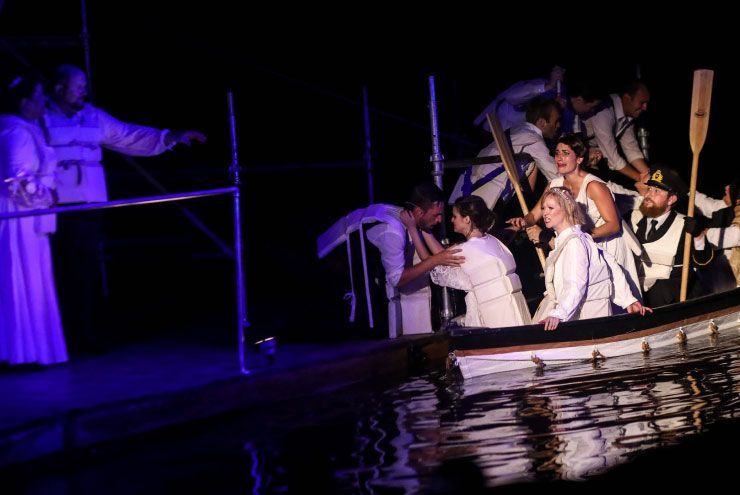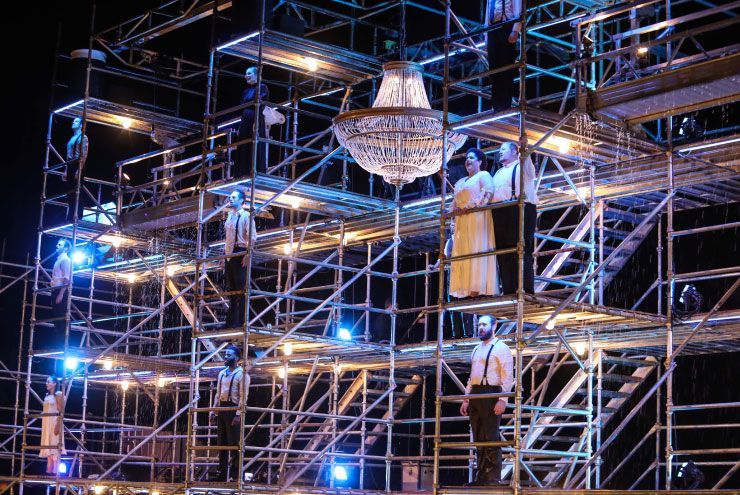By Barrett White
We wouldn’t be the first, second, or even third to use the word “intrepid” when describing the work produced by Serenbe Playhouse. The small professional theatre company, located about 30 miles southwest of Atlanta, performs all of its productions on a large expanse of acreage attached to The Inn at Serenbe. Founded in 2009, the playhouse has made a name for itself within the Georgia theatre scene, garnering national attention and press for its bold new works and reimagined classics that both push boundaries and illuminate the human experience.
Brian Clowdus, a handsome, whip-smart, openly gay man with a charming southern drawl, is the founder and artistic director behind the company. He notes that, while spectacle is awe-inspiring, it’s the visceral reactions that he’s after. Clowdus received his first major wave of national press in 2016 when he decided to use an actual helicopter for their production of Miss Saigon during the company’s seventh season.
Chris Brent Davis, out music director for the Playhouse, laughs over the mention of the infamous helicopter. “[Brian] said ‘we’re landing a helicopter’ on day one! The day we announced the show!”
“I’m a big believer of speaking things into existence,” Clowdus says. “And it’s not just about the spectacle. For me, [the helicopter scene] was the climax of the show, and how do you simulate something that feels that way without the real thing? And without a ceiling, there’s no reason why we couldn’t. To see the people running out of the embassy, trying to get to the helicopter—seeing the wind blowing the audience’s hair around, and [the actors] screaming and crying—I get chills just thinking about it.”
The company’s most recent endeavor came not by air, but by sea. The Playhouse’s 2018 season theme is “Voyage,” featuring shows set out at sea, like The Little Mermaid and Peter Pan. The headline-stealer of the season, however, was not a children’s show, but one of the most dramatic true stories in history, Titanic. With a set built entirely over water by fearless designer Adam Koch, the stakes were high.
The musical premiered on Broadway the same year as the James Cameron film, though the two are not related in any way but the setting. Like the film, the musical was a critical success. The vocal-heavy show featuring the stories of real passengers cleaned up at the 1997 Tony Awards, winning all five categories in which it was nominated, including Best Musical. Titanic’s Broadway run ended after a healthy 804 performances, but 20 years later, it is not often produced outside of the occasional opera company or overseas production. “I’ve been wanting to produce Titanic for a while now. It’s been on the bucket list,” Clowdus shares. “I didn’t want to do the 20-person ensemble version. I wanted to do the full, epic, huge-cast version. We got the rights and then built the rest of the season around water . . . I talk about this show being about hope, not tragedy. Considering the place we’re in today, I thought it would be good to have a story about hope.”
With an impressive grant from the Home Depot Foundation, Clowdus’ vision for Titanic was realized, making this their most successful production to date. Oftentimes, standing room only seats had to be sold.
Everything down to the minutiae of the show was brilliantly executed by Clowdus and his team. Mounds of luggage and White Star Line memorabilia littered the grounds from the entrance to the concessions to the stadium seating at the edge of the lake. As the show began, a gorgeous chandelier raised from the water and lit midair to symbolize the story being brought back from the depths. Cast colorblind and age-blind, the passengers reflected the society around us today—hopeful and diverse. “I was casting for storytellers,” Clowdus says. “I wanted the actors to embody the story. I didn’t want a carbon copy. We’re all about telling stories.”
“We need to see the spirit of the characters, so we do a reading of descriptions of the characters,” Davis adds.
With a true story like Titanic, a certain responsibility is handed to the 40 actors portraying real people. Plenty of media is based on the lives of celebrities, but for the real passengers of the Titanic, this is the only representation they have. To bring these important stories to life, Serenbe enlisted some of its most talented actors, many of whom are also openly gay.
Brian Jordan portrayed 16-year-old bellboy Edward Henry Harris, whose character in the show was actually based on the combined stories of two brothers who perished in the disaster, Clifford Henry Harris, a bellboy, and his brother, who was a steward.
Henry Etches, a bedroom steward for passengers traveling first class, survived the sinking and went on to testify at the hearings in New York. His experience was brought to life by Equity actor Brian Thorpe in the Serenbe production.
The characters of Etches and Harris were together most of the show, the latter under the former’s wing. At the onset of the show, the crew boarded by a gangway from the audience to the “ship,” a towering skeleton set that the cast filled with life. Next, the third class passengers, then second class, then first class (the roster of first class passengers, by the way, was hilariously introduced one by one by the exquisite Shannon McCarren, who played the bubbly, harmless social climber, Alice Beane).
Once aboard, the gangway was detached from the audience, becoming a part of the ship itself. For the next two and a half hours, the cast was isolated from land and truly out to sea. “It was really interesting reading the history on all of these people,” Thorpe says. “It really helped in fleshing out the relationships between each of the passengers and the crew. And that’s good, because we’re always active on the ship. We’re always having conversations, and we [Harris and Etches] have scenes where we’re like, ‘Okay, let’s go clean’ between scenes.”
“They’re out there the whole time,” adds Tyler Beddoe, the Playhouse’s director of sales and development. “It’s incredible; in each of their classes, they interact and have scenes throughout the whole show, even in the dark.”
“We don’t play the end, the sinking,” says Jordan. “At the beginning, there’s such optimism and hope, but we can’t play heavy like we know what’s to come. It adds to not only the optimism of the passengers, but the confidence of the era in which it’s set.”
“The night was alive with a thousand voices,” sang the character Harold Bride, the Marconi telegraph operator (played by Chase Davidson), as he joyously recalled his discovery of the machine that put him in touch with the world. This line is cleverly, if not hauntingly, reprised during the sinking, as passengers clamored for lifeboats and tearfully said goodbye to their loved ones while the ship sank out from under them.

“Actual lifeboats rowed from the set, separating husband and wife as real tears streamed down the faces of the newlyweds, mothers, and partners departing the ship, ablaze with light, into the dark of the unknown sea.” -Barrett White. Photo by Breeanne Clowdus.
As the Titanic went down, the limitations in place at an indoor theatre were a non-issue for Serenbe. The passengers donned their lifebelts and sang songs of confusion and a terror bubbling to the surface. The captive audience jumped at the crack of a distress flare shot from the bow of the ship. Actual lifeboats rowed from the set, separating husband and wife as real tears streamed down the faces of the newlyweds, mothers, and partners departing the ship, ablaze with light, into the dark of the unknown sea. “They’ve spent the last two hours together on that set,” Davis explains. “It makes the lifeboat scene so easy to step into. It’s easy to lose it. It’s like, ‘I’ve just spent the last two hours with this person, and now you’re telling me I have to leave them?’ It’s easy to make it real when it is. There was no option for them.”
Perhaps the most moving scene in the production came when Isador and Ida Strauss, known popularly as the “old couple in the bed” as the ship sinks in the film, take their fate into their own hands. After 40 years together, Ida (Lilliangina Quinones) adamantly refused a seat in the lifeboat, opting to stay with her husband, Isador (Robert Wayne). The couple stood face to face, professing their love for one another 30 feet above the water. Their love song crescendoed as the platform sank beneath the waves and enveloped the couple. The lights faded to black. Never before have I heard an audience so shocked by an image, that even the singing insects of central Georgia gave pause.
Thomas Andrews (Chris Sizemore), the ship’s designer, imagined how his blueprints could have been changed to prevent such a sinking while detailing the fate of the passengers around him. “More than 250 feet they will fall, and after that, I cannot say,” he cried, while actors dangled from the set before plummeting to the water beneath them. Subtly, the passengers left to fend for themselves signaled to hidden lifeguards that they landed safely.
The chandelier dimmed as it slipped back beneath the surface.
The colossal cast looked to the set in wonder, “A chapel ceiling screaming one man’s ecstasy . . . miracles, them all,” the ensemble recited in perfect harmony, calling to mind manmade feats equal to the grandeur of the Titanic. “China’s endless wall, Stonehenge, The Parthenon, the Duomo, the aqueducts of Rome…”
Though Titanic closed on August 19, the theatre’s ninth season will continue with an adapted version of Chekov’s The Seagull, which will run through September, followed by an immersive theatre production called The Sleepy Hollow Experience, just in time for Halloween, running from the end of September until the first week of November.
If Titanic is any indication, I’d say get your tickets to what’s left of season nine before these shows sail away into Serenbe history.
To follow announcements about Serenbe’s upcoming seasons, check out their official website, find them on Facebook, or follow them on Instagram at @serenbeplayhouse.








Sue
August 22, 2018 at 3:31 PMBarrett-what a great article. I saw the play twice and was amazed both times. Truly Brian and his team have a gift in creating these productions. We have been members for a couple years and am so grateful to experience the outdoors this way. Much nicer driving to Serenbe than to Atlanta from Douglasville for a play.